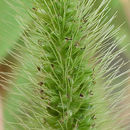Comments
provided by eFloras
This robust, annual species is frequently confused with large forms of Setaria viridis, but has broader, acute spikelets and a shorter upper glume clearly exposing the tip of the upper lemma.
- license
- cc-by-nc-sa-3.0
- copyright
- Missouri Botanical Garden, 4344 Shaw Boulevard, St. Louis, MO, 63110 USA
Description
provided by eFloras
Annual. Culms solitary, erect or geniculate and rooting at the lowermost nodes, 50–120 cm tall, up to 6 mm in diam., glabrous. Leaves all cauline; leaf sheaths ciliate on upper margins; leaf blades broadly linear, 10–40 × 0.5–2 cm, glabrous or adaxial surface with scattered hairs, narrowed to base, apex acuminate; ligule 1–2 mm. Panicle densely cylindrical, 5–24 × 0.6–1.3 cm, nodding, branchlets bearing several spikelets each subtended by 1–3 bristles; axis white-pilose; bristles green or brownish purple, 10–15 mm. Spikelets elliptic, 2.8–3 mm, glumes and lower lemma thinly membranous; lower glume 1/3–1/2 as long as spikelet; upper glume 2/3–3/4 as long as spikelet; lower floret neuter; lower palea up to 1/2 as long as lemma, sometimes very small; upper lemma finely rugose under upper glume, almost smooth on exposed apex. Fl. and fr. Jul–Oct. 2n = 36.
- license
- cc-by-nc-sa-3.0
- copyright
- Missouri Botanical Garden, 4344 Shaw Boulevard, St. Louis, MO, 63110 USA
Habitat & Distribution
provided by eFloras
Mountain slopes, roadsides, waste places. Anhui, Fujian, Guangxi, Guizhou, Heilongjiang, Henan, Hubei, Hunan, Jiangsu, Jiangxi, Jilin, Shandong, Sichuan, Taiwan, Yunnan, Zhejiang [Japan, Korea; introduced in North America].
- license
- cc-by-nc-sa-3.0
- copyright
- Missouri Botanical Garden, 4344 Shaw Boulevard, St. Louis, MO, 63110 USA
Physical Description
provided by USDA PLANTS text
Annuals, Terrestrial, not aquatic, Stems trailing, spreading or prostrate, Stems nodes swollen or brittle, Stems geniculate, decumbent, or lax, sometimes rooting at nodes, Stems caespitose, tufted, or clustered, Stems terete, round in cross section, or polygonal, Stem internodes solid or spongy, Stem internodes hollow, Stems with inflorescence less than 1 m tall, Stems with inflorescence 1-2 m tall, Stems, culms, or scapes exceeding basal leaves, Leaves mostly cauline, Leaves conspicuously 2-ranked, distichous, Leaves sheathing at base, Leaf sheath mostly open, or loose, Leaf sheath smooth, glabrous, Leaf sheath hairy, hispid or prickly, Leaf sheath and blade differentiated, Leaf blades linear, Leaf blades 2-10 mm wide, Leaf blades 1-2 cm wide, Leaf blades mostly flat, Leaf blades more or less hairy, Ligule present, Ligule a fringe of hairs, Inflorescence terminal, Inflorescence a dense slender spike-like panicle or raceme, branches contracted, Inflorescence solitary, with 1 spike, fascicle, glomerule, head, or cluster per stem or culm , Inflorescence lax, widely spreading, branches drooping, pendulous, Inflorescence spike linear or cylindric, several times longer than wide, Flowers bisexual, Spikelets pedicellate, Spikelets sessile or subsessile, Spikelets dorsally compressed or terete, Spikelet less than 3 mm wide, Spikelets with 1 fertile floret, Spikelets with 2 florets, Spikelet with 1 fertile floret and 1-2 sterile florets, Spikelets solitary at rachis nodes, Spikelets all alike and fertille, Spikelets bisexual, Spikelets disarticulating below the glumes, Spikelets all subtended by bristles, Spikelet bristles 1-3, Spikelet bracts bristles not disarticulating with spikelets, Glumes present, empty bracts, Glumes 2 clearly present, Glumes distinctly unequal, Glumes shorter than adjacent lemma, Glume equal to or longer than spikelet, Glumes 3 nerved, Glumes 4-7 nerved, Lemmas thin, chartaceous, hyaline, cartilaginous, or membranous, Lemma similar in texture to glumes, Lemma becoming indurate, enclosing palea and caryopsis, Lemma 5-7 nerved, Lemma glabrous, Lemma rugose, with cross wrinkles, or roughened, Lemma apex acute or acuminate, Lemma awnless, Lemma margins thin, lying flat, Lemma straight, Palea present, well developed, Palea shorter than lemma, Palea 2 nerved or 2 keeled, Stamens 3, Styles 2-fid, deeply 2-branched, Stigmas 2, Fruit - caryopsis.
Setaria faberi: Brief Summary
provided by wikipedia EN
Setaria faberi, the Japanese bristlegrass, nodding bristle-grass, Chinese foxtail, Chinese millet, giant bristlegrass, giant foxtail or nodding foxtail, is an Asian grass. It is a summer annual, with plants emerging from seeds in the spring, and setting seeds in the late summer or fall.
Giant foxtails prefer compacted soils, high in nitrogen and phosphorus. The plant gains a competitive edge on crops as the soil pH increases.
- license
- cc-by-sa-3.0
- copyright
- Wikipedia authors and editors

